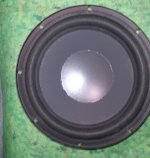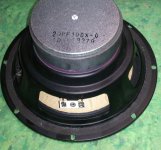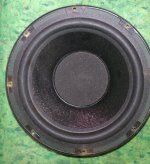If I was to SHOW you two drivers & you had to pick one - what would you choose? Both drivers are 8" and salvaged from ported cabinets with less than 20 litres.
In the RED corner: weighing in at 75w RMS is the JVC boasting just 3 ohms of resistance.
In the BLUE corner: The mighty Soundware XS driver. 100w of RMS power, more Xmax, champion 6 ohm driver.
You can have either for free
Which?
In the RED corner: weighing in at 75w RMS is the JVC boasting just 3 ohms of resistance.
In the BLUE corner: The mighty Soundware XS driver. 100w of RMS power, more Xmax, champion 6 ohm driver.
You can have either for free
Which?
You can have either for free
In this case, and without any other informations, I would rather take both and test them for choosing afterwards...
But it's me, OK ? 😉
T
True. If everything else is equal, then 100 watts and more xmax wins hands down.Power handling and xmax are not directly comparable given neither has a definition.
dave
If all else were equal, but then more Xmax normally means reduced sensitivity.
Surtsey, did you have something in mind or is this a fishing expedition?
Surtsey, did you have something in mind or is this a fishing expedition?
The driver with larger Xmax will produce the highest clean SPL at low frequencies. In a 3-way the high frequency limit won't matter because any 8" driver will be clean up to 300 Hz. In a 2-way the cone breakup frequency will matter a lot.
The driver with larger Xmax will produce the highest clean SPL at low frequencies
xMax alone is not enuff to determine that. And it isn’t necessarily the deal clincher since it is only 1 aspect.
Let’s see the woofers...
dave
The physical (visible) characteristics of a woofer/mid-woofer could give certain hints about its performance.
Further, for a disassembled woofer, the height of the voice-coil together with the depth of the gap can indicate Xmax capability, linearity (fidelity) and efficiency. The presence (or lack) of demodulation rings, magnet structure etc. can also give some hints about distortion performance.
Hope that helps.
- The surround material (PU, cloth) and bends (roll, accordion etc.) indicate suspension compliance, excursion, linearity etc.
- The cone material (paper / pulp / other), shape (straight / curvilinear), depth and reinforcement (ribs etc.) indicate certain breakup tendencies (or lack thereof) and application (sub / 2-way / 3-way).
- The size of the voice coil, basket material (aluminium vs. steel) , presence of vents etc. indicate thermal handling.
- Magnet type - Ferrite / Alnico indicates midband distortion characterisics
Further, for a disassembled woofer, the height of the voice-coil together with the depth of the gap can indicate Xmax capability, linearity (fidelity) and efficiency. The presence (or lack) of demodulation rings, magnet structure etc. can also give some hints about distortion performance.
Hope that helps.
Subjective tests done: 16l ported.
The JVC proved slightly louder - I guess 3 ohms will do that. Bass response was warm and smooth.
The Boston Acoustic drivers delivered more punch, more deliberate, more dynamic on the kicks. It's response seem faster if that's an actual thing.
I've learned nothing substantial. At reasonable listening levels the JVC wins by the slimmest of margins but pump up the volume, the Boston Acoustics driver gets to strut its stuff, easily outpointing its counterpart.
The JVC proved slightly louder - I guess 3 ohms will do that. Bass response was warm and smooth.
The Boston Acoustic drivers delivered more punch, more deliberate, more dynamic on the kicks. It's response seem faster if that's an actual thing.
I've learned nothing substantial. At reasonable listening levels the JVC wins by the slimmest of margins but pump up the volume, the Boston Acoustics driver gets to strut its stuff, easily outpointing its counterpart.
This could be the result of a more extended response in the upper direction. EQ them both the same, as you might if you cross them, and the difference may not be so clear.more punch, more deliberate, more dynamic on the kicks. It's response seem faster if that's an actual thing.
This could be the result of a more extended response in the upper direction. EQ them both the same, as you might if you cross them, and the difference may not be so clear.
For testing purposes (I sell a lot on Ebay) I use an old Home Theatre amp. Subs are tested using the subwoofer output (X 120Hz). I set the units on a stool in the middle of the room and always listen from the same spot.
Ok, that's a good start. I still think the relative amount of higher bass energy could differ noticeably.. along with the properties of the main resonance and any others, which can all come down to the response.
Ok, that's a good start. I still think the relative amount of higher bass energy could differ noticeably.. along with the properties of the main resonance and any others, which can all come down to the response.
The most interesting thing I've learned from my testing method: I use a Tannoy SFX sub (plate amp removed) as my 8" benchmark. All other drivers are tested in the "Dumpster Sub" box. Invariably, the Tannoy is the worst performer.
Who knew?
- Home
- Loudspeakers
- Subwoofers
- What can you learn from the physical characteristics of a driver?


